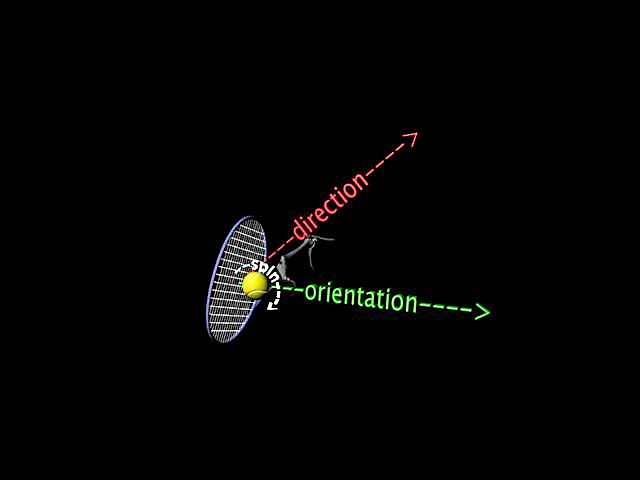The Flourish
The flourish is a make-or-break component of any stroke. This was the last piece of the puzzle from me for me because I am was so poisened by the pernicious, pitch-dark pearl that commanded players "Hit through the ball!" On its face, that aphorism is valid. The racket cannot hit the ball without passing through the point of contact. When I heard it, however, I imagined it meant "Drive the racket through the ball!" This intrerpretation is desperately wrong and a recipe for disaster. If you 'drive through' the ball, making no effort to slow the acceleration of the racket before the moment of contact, any control forces you may have stored in your forearm muscles will not be released until after the ball has left the strings. Consequently there will be no control. This is how a easy, relaxed, shoulder-high volley can end up in the base of the net or the back fence. The solution to this problem is almost trivial: start stopping the racket before it hits the ball. Start stopping is not a typo, it is an order. It means that whatever gyrations you employed to get the racket going forward must be reversed before the moment of contact. Now, while I admit that this is easier said than done, you are most likely already doiong it, at least on some of your attempts at stroking. The old entreaty to "Step into the ball!" was not a recipe for adding footspeed to racket head speed, nor even a reminder to set your back foot in order to generate forward rotational momentum, though that is how I, and I suspect many of you, internalized it. Talentoids, given this command as beginners, quickly found that with the correct timing of this step towards the ball they could achieve enhanced, even amazing control over the ball's flight path. Thier enhanced neurokinetics, muscle memory, and body awareness helped them to 'step in' at just the right moment; late in the stroke but well before the moment of contact. The enhanced ground contact enabled them to push back against the forward momentum of thier hips and shoulders, decelerating their arms and alowing the control and spin forces stored in their forarms to be suddenly released into the ball (the EXPLODE). This counter-rotation is absolutely essential for control and applies to every stroke in tennis. There is no control without it. If we swing through the ball and it somehow ends up falling into our opponent's court, it is because the incoming angle of the ball and the direction of the racket face propitiously coincide. It is luck, not control. It is why so many of our shoulder high volleys end up in the base of the net.
How to Start Stopping
The act of stopping the forward momentum of a stroke in time to release the stored control and spin forces before the moment of contact boils down to a simple matter of will. You need to develop the intention of stopping the stroke, then express that intention before impact. The best and only way I have found to accomplish this feat is to plan a pause or pose in the swing that occurs immediately after the ball leaves the strings. The timing is critical, but your brain can handle it. Generally one does not suspend the follow through completely, just slow the racket down with sufficient abruptness to end the snap and release the impulse forces. It is serendipitous that this pause usually occurs in front of you within your field of view, so if you fail to to strike a pose, you will immediately know it. You will still miss, but you can do better next time. I call the pose that comes after contact a "flourish" since it is a recognizable gesture that occurs at the end and appears to be completely useless. In fact, the stroke cannot be completely successful without it.
The serve flourish is often mistakenly identified as 'pronation' or 'snapping the wrist.' The movement of the racket at the end of the serve is certainly eye catching, but you are neither intentionally pronating nor flexing the wrist during the serve flourish. All you are doing is stopping your shoulder and upper arm which releases stored forces and momentum to simulate intentional forarm pronation and wrist flexion. These these forces are created and stored in the windup of the serve, specifically during the load or pendulum phase. It is your intention to created this moment of 'pseudo-pronation' that motivates you to stop the forward motion of the upper arm and shoulders before the moment of contact. The pronation forces contribute control, spin, and pace producing, impulse forces. The pronation motion does nothing. Pronation is just part of the flourish, but for that reason it is important to acheive it. If you 'swing through' the serve, i.e. fail to stop your upper arm, no control forces will be released and your serve will be weak and wild with anemic spin.

